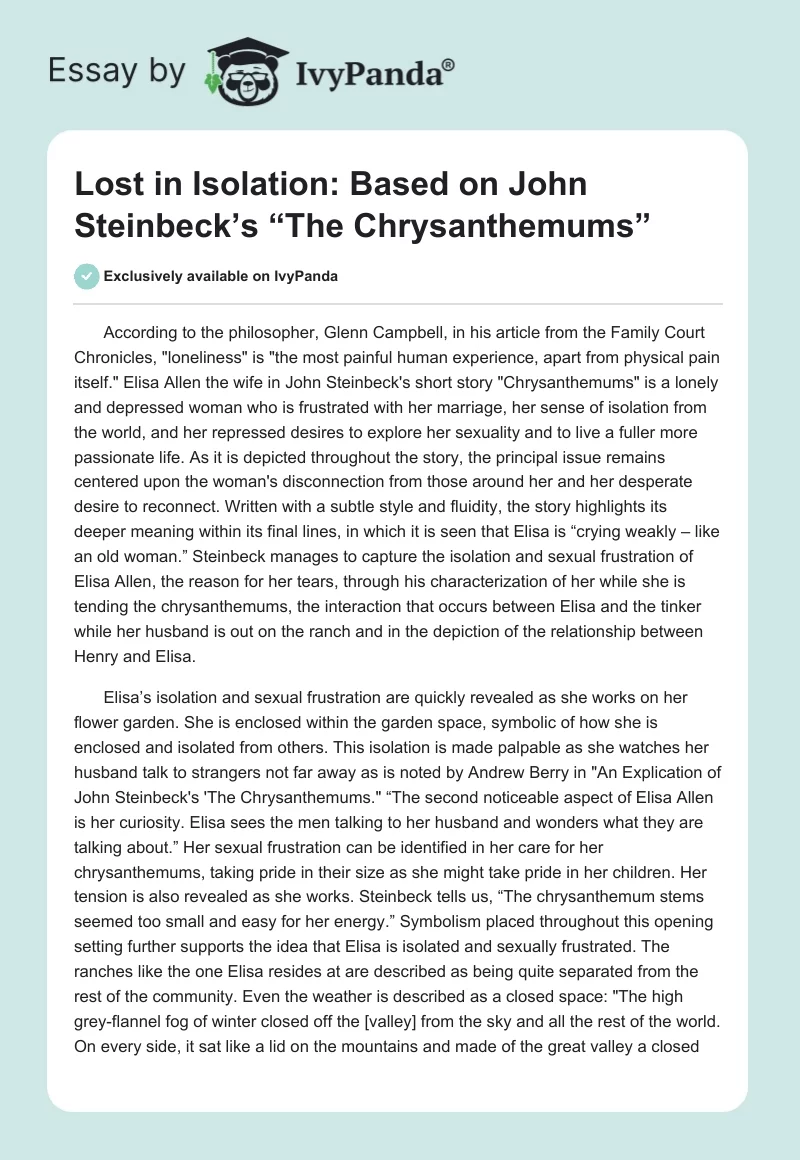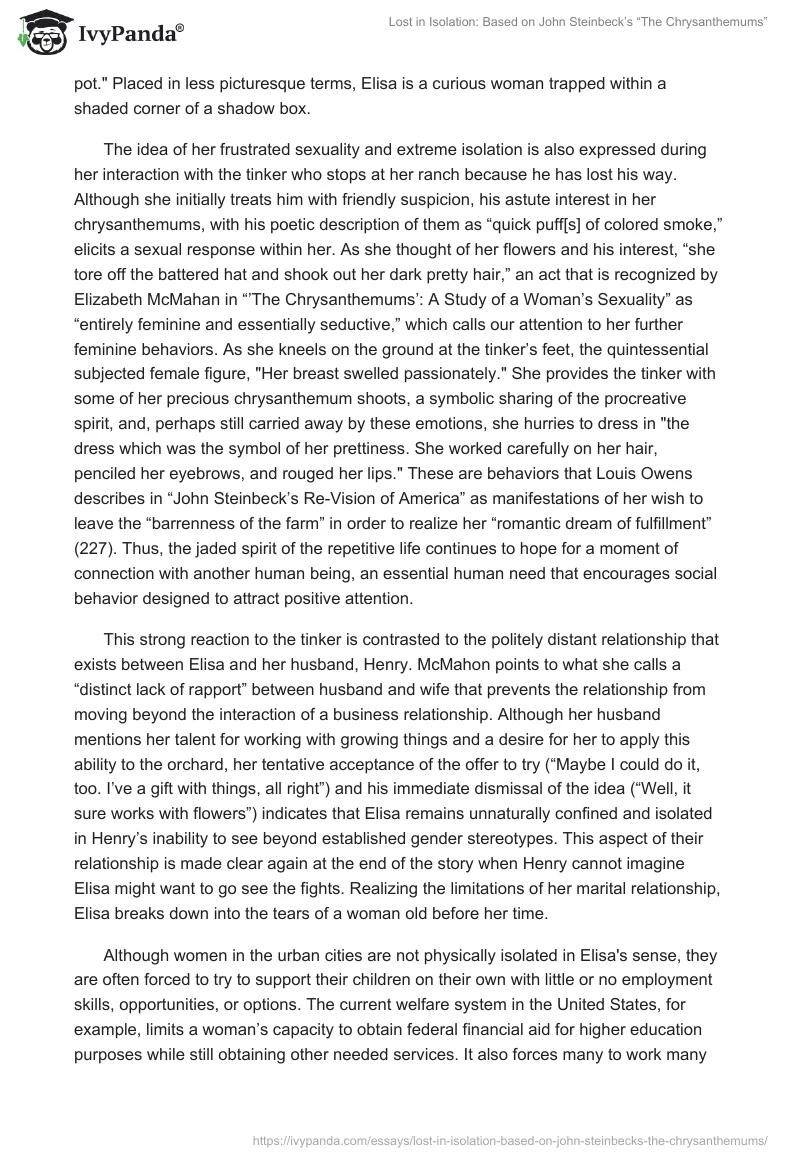According to the philosopher, Glenn Campbell, in his article from the Family Court Chronicles, “loneliness” is “the most painful human experience, apart from physical pain itself.” Elisa Allen the wife in John Steinbeck’s short story “Chrysanthemums” is a lonely and depressed woman who is frustrated with her marriage, her sense of isolation from the world, and her repressed desires to explore her sexuality and to live a fuller more passionate life. As it is depicted throughout the story, the principal issue remains centered upon the woman’s disconnection from those around her and her desperate desire to reconnect. Written with a subtle style and fluidity, the story highlights its deeper meaning within its final lines, in which it is seen that Elisa is “crying weakly – like an old woman.” Steinbeck manages to capture the isolation and sexual frustration of Elisa Allen, the reason for her tears, through his characterization of her while she is tending the chrysanthemums, the interaction that occurs between Elisa and the tinker while her husband is out on the ranch and in the depiction of the relationship between Henry and Elisa.
Elisa’s isolation and sexual frustration are quickly revealed as she works on her flower garden. She is enclosed within the garden space, symbolic of how she is enclosed and isolated from others. This isolation is made palpable as she watches her husband talk to strangers not far away as is noted by Andrew Berry in “An Explication of John Steinbeck’s ‘The Chrysanthemums.” “The second noticeable aspect of Elisa Allen is her curiosity. Elisa sees the men talking to her husband and wonders what they are talking about.” Her sexual frustration can be identified in her care for her chrysanthemums, taking pride in their size as she might take pride in her children. Her tension is also revealed as she works. Steinbeck tells us, “The chrysanthemum stems seemed too small and easy for her energy.” Symbolism placed throughout this opening setting further supports the idea that Elisa is isolated and sexually frustrated. The ranches like the one Elisa resides at are described as being quite separated from the rest of the community. Even the weather is described as a closed space: “The high grey-flannel fog of winter closed off the [valley] from the sky and all the rest of the world. On every side, it sat like a lid on the mountains and made of the great valley a closed pot.” Placed in less picturesque terms, Elisa is a curious woman trapped within a shaded corner of a shadow box.
The idea of her frustrated sexuality and extreme isolation is also expressed during her interaction with the tinker who stops at her ranch because he has lost his way. Although she initially treats him with friendly suspicion, his astute interest in her chrysanthemums, with his poetic description of them as “quick puff[s] of colored smoke,” elicits a sexual response within her. As she thought of her flowers and his interest, “she tore off the battered hat and shook out her dark pretty hair,” an act that is recognized by Elizabeth McMahan in “’The Chrysanthemums’: A Study of a Woman’s Sexuality” as “entirely feminine and essentially seductive,” which calls our attention to her further feminine behaviors. As she kneels on the ground at the tinker’s feet, the quintessential subjected female figure, “Her breast swelled passionately.” She provides the tinker with some of her precious chrysanthemum shoots, a symbolic sharing of the procreative spirit, and, perhaps still carried away by these emotions, she hurries to dress in “the dress which was the symbol of her prettiness. She worked carefully on her hair, penciled her eyebrows, and rouged her lips.” These are behaviors that Louis Owens describes in “John Steinbeck’s Re-Vision of America” as manifestations of her wish to leave the “barrenness of the farm” in order to realize her “romantic dream of fulfillment” (227). Thus, the jaded spirit of the repetitive life continues to hope for a moment of connection with another human being, an essential human need that encourages social behavior designed to attract positive attention.
This strong reaction to the tinker is contrasted to the politely distant relationship that exists between Elisa and her husband, Henry. McMahon points to what she calls a “distinct lack of rapport” between husband and wife that prevents the relationship from moving beyond the interaction of a business relationship. Although her husband mentions her talent for working with growing things and a desire for her to apply this ability to the orchard, her tentative acceptance of the offer to try (“Maybe I could do it, too. I’ve a gift with things, all right”) and his immediate dismissal of the idea (“Well, it sure works with flowers”) indicates that Elisa remains unnaturally confined and isolated in Henry’s inability to see beyond established gender stereotypes. This aspect of their relationship is made clear again at the end of the story when Henry cannot imagine Elisa might want to go see the fights. Realizing the limitations of her marital relationship, Elisa breaks down into the tears of a woman old before her time.
Although women in the urban cities are not physically isolated in Elisa’s sense, they are often forced to try to support their children on their own with little or no employment skills, opportunities, or options. The current welfare system in the United States, for example, limits a woman’s capacity to obtain federal financial aid for higher education purposes while still obtaining other needed services. It also forces many to work many miles away from home and imposes stringent ‘moral’ requirements. While women in the middle and upper classes have the ability to more readily choose to combine family obligations and employment, freely practice their individual sexual orientations, and have an abortion, impoverished women subsisting on welfare do not have control over these life, or lifestyle issues, which becomes the focus of Rickie Solinger’s study “Dependency and Choice”. “Dependency has come to be associated with the ‘dangerous, pathological behavior’ of poor women who make wrong choices,” rather than the result of choices that have been made for them or the passing of years without any opportunities for choice. The policies of the current welfare system are intended to force poor women to adjust their life choices so that they match with the prevailing view of ‘morality’ of those writing the legislation and to force an increasing number of women into low paying, esteem lowering jobs that provide little or usually, no benefits at all.
Steinbeck’s characterization of Elisa in terms of her activities and setting, her encounter with the tinker and the relationship she experiences with her husband as it is revealed in this short story expresses the loneliness and frustration of women living away from the companionship of a larger society and confined within the strict bounds of a masculine perception. Yet, the story remains applicable today as thousands of women remain confined within bounds equally as constricting as those described for Elisa. Women in the lower ranks of society are thus just as isolated from true connections with others due to their overworked schedule as a means of survival, desperate for a little attention from anyone willing to spend a little time with them, and trapped within a constrained world of expectations and behaviors with little or no control over where she will go or what she will do.
Works Cited
Berry, Andrew. “An Explication of John Steinbeck’s ‘The Chrysanthemums’.” Associated Content. 2008. Web.
McMahan, Elizabeth E. “’The Chrysanthemums’: A Study of a Woman’s Sexuality.” Short Story Criticism. Vol. 11, (1992): 214-217.
Owens, Louis. “John Steinbeck’s Re-Vision of America.” Short Story Criticism. Vol. 11, (1992): 225-232.
Solinger, Rickie. “Dependency and Choice.” Social Justice. Vol. 25, N. 1, (1998). 2008. Web.
Steinbeck, John. “The Chrysanthemums.” The Long Valley. New York: Penguin Books, (1995): 1-13.


